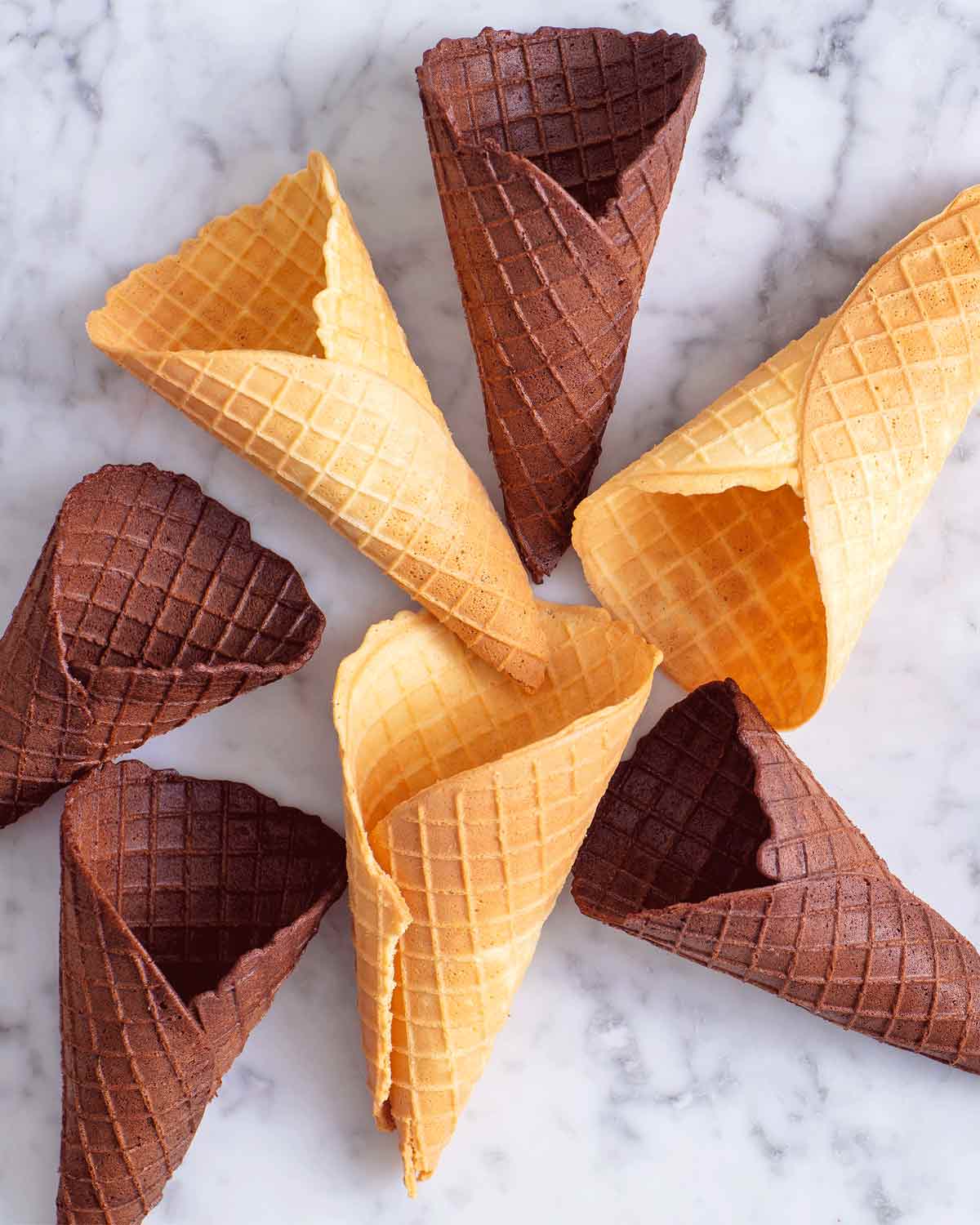Download (right-click, save target as ...) this page as a jupyterlab notebook Lab20-TH
Laboratory 20: Regression Goodness of Fit
LAST NAME, FIRST NAME
R00000000
ENGR 1330 Laboratory 20 - Homework
# Preamble script block to identify host, user, and kernel
import sys
! hostname
! whoami
print(sys.executable)
print(sys.version)
print(sys.version_info)
Exercise: Ice Cream Cones!

The 'icecreamcone.csv' file, has the recordings on daily temperature, relative humidity, cone strength, and cone weight based on noon readings for 20 days of cone making. Follow the steps and answer the following questions:¶
Step1: Read the "icecreamcone.csv" file as a dataframe. Explore the dataframe and in a markdown cell breifly describe it in your own words.
Step2: Calculate and compare the correlation coefficient of the cone's weight with all the other parameters. In a markdown cell, explain the results and state which parameters have the strongest and weakest relationship with the cone's weight of a vehicle.
Step3: Use linear regression modeling with statsmodels, get the linear model's coefficients, make a plot and VISUALLY assess the quality of a linear fit with humidity as the predictor, and cone's weight as outcome. Then, use RMSE, Pearson's r, and NSE to describe the performance of your model. Explain the result of this analysis in a markdown cell.
Step4: Use linear regression modeling with statsmodels, get the linear model's coefficients, make a plot and VISUALLY assess the quality of a linear fit with cone's strength as the predictor, and cone's weight as outcome. Then, use RMSE, Pearson's r, and NSE to describe the performance of your model. Explain the result of this analysis in a markdown cell.
Step5: Use multiple linear regression modeling with scikit-learn and use all the three predictor parameters to predict cone's weight. Then, use RMSE, Pearson's r, and NSE to describe the performance of your model. Explain the result of this analysis in a markdown cell.
Step6: As a conclusion, make a statement about the quality of the three predictive models you wrote and compare their performances.
Data Source: V.T. Huang, S.T. Luebbers, J.B. Lindamood, P.M.T. Hansen (1989). "Ice Cream Cone Baking: 2. Textured Characteristics of Rolled Sugar Cones," Food Hydrocolloids, Vol. 3, #1, pp. 41-55.
import requests # Module to process http/https requests
remote_url="http://54.243.252.9/engr-1330-webroot/4-Databases/icecreamcone.csv" # set the url
rget = requests.get(remote_url, allow_redirects=True) # get the remote resource, follow imbedded links
open('icecreamcone.csv','wb').write(rget.content); # extract from the remote the contents, assign to a local file same name
#Step1:Read the "icecreamcone.csv" file as a dataframe
# Explore the dataframe: Describe the df
#Step2: Calculate and compare the correlation coefficient
#What can we infer?
#Step3: humidity as the predictor
#GOF metrics:
#Step4: strength as the predictor
#GOF metrics:
#Step5: 3 predictor - Multiple Linear Regression
#GOF metrics:
#Step6:
References¶
This notebook was inspired by several blogposts including:
- "Introduction to Linear Regression in Python" by Lorraine Li available at* https://towardsdatascience.com/introduction-to-linear-regression-in-python-c12a072bedf0
- "In Depth: Linear Regression" available at* https://jakevdp.github.io/PythonDataScienceHandbook/05.06-linear-regression.html
- "A friendly introduction to linear regression (using Python)" available at* https://www.dataschool.io/linear-regression-in-python/
- "What is Maximum Likelihood Estimation — Examples in Python" by Robert R.F. DeFilippi available at* https://medium.com/@rrfd/what-is-maximum-likelihood-estimation-examples-in-python-791153818030
- "Linear Regression" by William Fleshman available at* https://towardsdatascience.com/linear-regression-91eeae7d6a2e
- "Regression Accuracy Check in Python (MAE, MSE, RMSE, R-Squared)" available at* https://www.datatechnotes.com/2019/10/accuracy-check-in-python-mae-mse-rmse-r.html
Here are some great reads on these topics:
- "Linear Regression in Python" by Sadrach Pierre available at* https://towardsdatascience.com/linear-regression-in-python-a1d8c13f3242
- "Introduction to Linear Regression in Python" available at* https://cmdlinetips.com/2019/09/introduction-to-linear-regression-in-python/
- "Linear Regression in Python" by Mirko Stojiljković available at* https://realpython.com/linear-regression-in-python/
- "A Gentle Introduction to Linear Regression With Maximum Likelihood Estimation" by Jason Brownlee available at* https://machinelearningmastery.com/linear-regression-with-maximum-likelihood-estimation/
- "Metrics To Evaluate Machine Learning Algorithms in Python" by Jason Brownlee available at* https://machinelearningmastery.com/metrics-evaluate-machine-learning-algorithms-python/
- "A Gentle Introduction to Maximum Likelihood Estimation" by Jonathan Balaban available at* https://towardsdatascience.com/a-gentle-introduction-to-maximum-likelihood-estimation-9fbff27ea12f
- "Regression: An Explanation of Regression Metrics And What Can Go Wrong" by Divyanshu Mishra available at* https://towardsdatascience.com/regression-an-explanation-of-regression-metrics-and-what-can-go-wrong-a39a9793d914
- "Tutorial: Understanding Regression Error Metrics in Python" available at* https://www.dataquest.io/blog/understanding-regression-error-metrics/
Here are some great videos on these topics:
- "StatQuest: Fitting a line to data, aka least squares, aka linear regression." by StatQuest with Josh Starmer available at* https://www.youtube.com/watch?v=PaFPbb66DxQ&list=PLblh5JKOoLUIzaEkCLIUxQFjPIlapw8nU
- "Statistics 101: Linear Regression, The Very Basics" by Brandon Foltz available at* https://www.youtube.com/watch?v=ZkjP5RJLQF4
- "How to Build a Linear Regression Model in Python | Part 1" and 2,3,4! by Sigma Coding available at* https://www.youtube.com/watch?v=MRm5sBfdBBQ
- "StatQuest: Maximum Likelihood, clearly explained!!!" by StatQuest with Josh Starmer available at* https://www.youtube.com/watch?v=XepXtl9YKwc
- "Maximum Likelihood for Regression Coefficients (part 1 of 3)" and part 2 and 3 by Professor Knudson available at* https://www.youtube.com/watch?v=avs4V7wBRw0
- "StatQuest: R-squared explained" by StatQuest with Josh Starmer available at* https://www.youtube.com/watch?v=2AQKmw14mHM